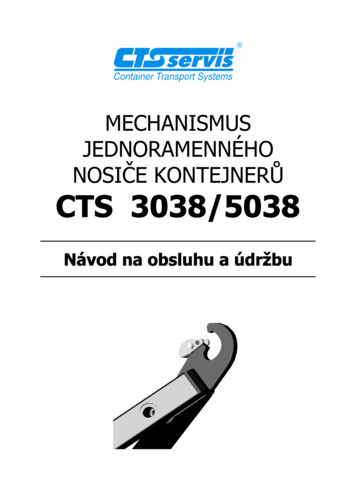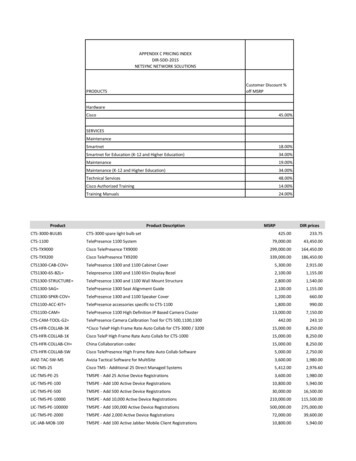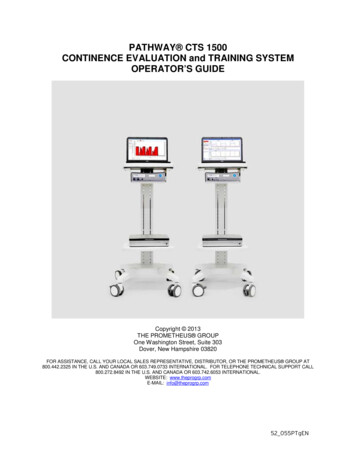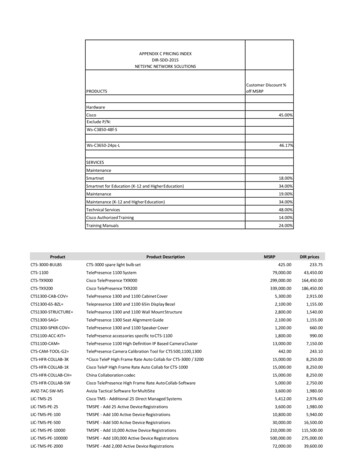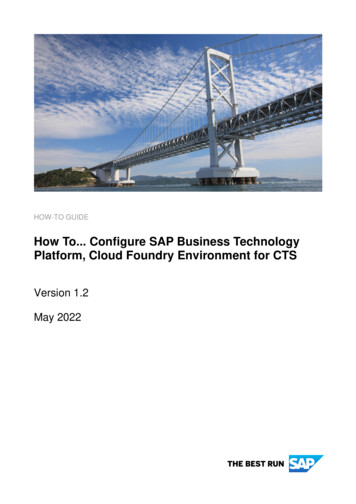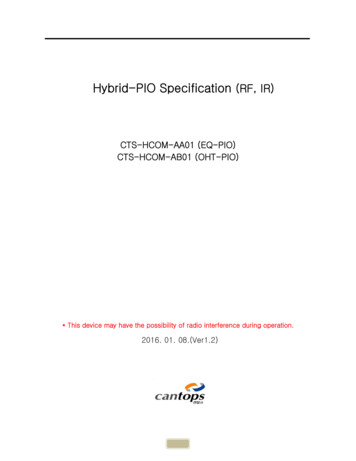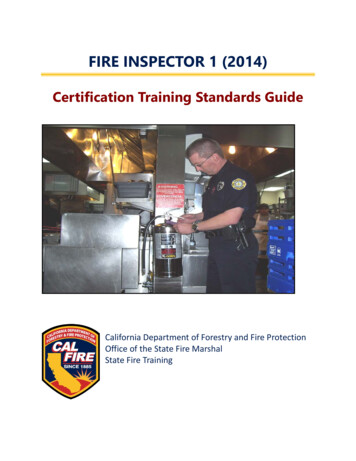
Transcription
FIRE INSPECTOR 1 (2014)Certification Training Standards GuideCalifornia Department of Forestry and Fire ProtectionOffice of the State Fire MarshalState Fire Training
Fire Inspector 1 (2014)Certification Training Standards GuideNFPA 1031 (2014) Fire Inspector 1September 2019 EditionThis CTS guide utilizes NFPA 1031 Standard for Professional Qualifications for Fire Inspector andPlan Examiner (2014) to provide the qualifications for State Fire Training’s Fire Inspector 1certification.State Fire Training coordinated the development of this CTS guide. Before its publication, theStatewide Training and Education Advisory Committee (STEAC) and the State Board of FireServices (SBFS) recommended this CTS guide for adoption by the Office of the State FireMarshal (OSFM).Cover photo courtesy of Dennis Mathisen, Roseville Fire DepartmentPublished by State Fire Training2251 Harvard Street, Suite 400, Sacramento, CA 95815(916) 568-2911
Table of ContentsState Fire Training . 1Mission . 1The California Fire Service Training and Education System . 1Acknowledgments. 2How to Read a CTS Guide. 4Format . 4Content. 5Fire Inspector 1 . 6Section 1: Definition of Duties . 6Section 2: Administration. 8Section 3: Field Inspection . 14Section 4: Wildland Urban Interface Environments . 33State Fire Training Content. 34Errata . 37Certification History . 38
State Fire TrainingState Fire TrainingMissionTo enable the California Fire Service to safely protect life and property through education,training, and certification.The California Fire Service Training and Education SystemThe California Fire Service Training and Education System (CFSTES) was established to provide asingle statewide focus for fire service training in California. CFSTES is a composite of all theelements that contribute to the development, delivery, and administration of training for theCalifornia fire service. The authority for the central coordination of this effort is vested in theTraining Division of the California State Fire Marshal's Office with oversight provided by theState Board of Fire Services.CFSTES facilitates, coordinates, and assists in the development and implementation of standardsand certification for the California fire service. CFSTES:1. Administers the California Fire Academy System2. Provides accredited courses leading to certification and approved standardized trainingprograms for local and regional delivery3. Administers the national accreditation process in California4. Publishes certification training standards, course plans, and a capstone task book for eachcertified level in the California fire serviceCFSTES is a fire service system developed by the fire service, for the fire service. It is only assuccessful and effective as the people involved in it.November 2019Page 1 of 38
AcknowledgmentsAcknowledgmentsState Fire Training appreciates the hard work and accomplishments of those who built the solidfoundation on which this program continues to grow.State Fire Training gratefully acknowledges the following individuals and organizations for theirdiligent efforts and contributions that made the development and publication of this documentpossible.CAL FIREThom PorterDirector, CAL FIREMike RichwineActing State Fire MarshalAndrew HenningChief, State Fire TrainingRon ColemanChair, STEACCadre LeadershipCaryn PettyCadre LeaderDeputy State Fire Marshal, State Fire Training, Office of the State Fire MarshalCadre MembersChris FowlerSupervising Deputy State Fire Marshal III, State Fire Training, Office of theState Fire MarshalCindy MooreSupervising Deputy State Fire Marshal III, Fire and Life Safety, Office of theState Fire MarshalNovember 2019Page 2 of 38
AcknowledgmentsSandy MargullisSupervising Deputy State Fire Marshal III, Fire and Life Safety, Office of the StateFire MarshalJason NailonFire Marshal, San Marcos Fire DepartmentPaula DuewekeFire Inspector, Petaluma Fire DepartmentMichael MentinkFire Marshal, Moraga-Orinda Fire DepartmentIan HardageAssistant Fire Marshal, Santa Rosa Fire DepartmentNovember 2019Page 3 of 38
How to Read a CTS GuideHow to Read a CTS GuideState Fire Training develops a Certification Training Standards (CTS) Guide for a variety of jobfunctions in the fire service such as firefighter, driver/operator, fire instructor, and companyofficer. The CTS guide lists the requisite knowledge and skills and the job performancerequirements a person is expected to complete in order to become certified in a specificfunction. CTS guides are appropriate for fire service personnel and individuals in relatedoccupations pursuing State Fire Training certification.Each CTS guide serves as a foundation for the certification programs recommended for adoptionby the Office of the State Fire Marshal. Any certification program must be based on job-relatedknowledge and measurable performance standards. To master the knowledge and skills neededfor specialized operations, individuals will require additional training to augment theperformance standards included in the CTS guide.Within the CTS guide, it is impossible to capture the different policies and procedures of eachorganization in the California fire service. Individuals aspiring to meet State Fire Training’scertification training standards must do so in accordance with the codes, standards, regulations,policies, and standard operating procedures applicable within their own departments orjurisdictions.FormatEach certification training standard included in the CTS guide includes the following:Section HeadingThe section heading describes a general category for a group of training standards. For example,the Fire Marshal CTS includes the following sections: Administration, Risk Management,Community Relations, Professional Development, Regulatory Programs, Fire and Life Safety, andInvestigation. Each section contains one or more individual training standards.Training Standard TitleThe training standard title provides a general description of the performance requirementcontained within the standard.AuthorityThe CTS guide references each standard with one or more paragraphs of the correspondingNational Fire Protection Association (NFPA) Professional Qualifications. This ensures that eachfire service function within California's certification system meets or exceeds NFPA standards.November 2019Page 4 of 38
How to Read a CTS GuideWhen California requirements exceed the NFPA standard, the CTS guide cites the Office of theState Fire Marshal as the authority and prints the corresponding information in italics.GivenThis section lists the objects, equipment, materials, or facilities an individual needs in order toacquire the requisite knowledge and skills or to accomplish the job performance requirement(s)within a training standard.Requisite Knowledge and SkillsThis section lists the knowledge and skills that an individual must acquire in order to accomplishthe job performance requirement(s) within a training standard.This section does not include NFPA requisite knowledge or skills that are too general to teach orthat individuals should develop through life experiences. For example, a training standard wouldnot list “communicate orally and in writing” or “ability to relate interpersonally” unless theyspecifically apply to a job performance requirement about acquiring communication skills ordeveloping interpersonal relationships.Job Performance RequirementsThis section includes one or more written statements that describe a specific job-related taskand define measurable or observable outcomes. After an individual completes all courseworkand requisite requirements, the capstone task book process verifies completion of jobperformance requirements.ContentIn addition to the individual certification training standards, the CTS guide also includes StateFire Training Revisions and Errata pages.State Fire Training ContentLocated at the back of the CTS guide, this table documents any significant revisions made byState Fire Training to the NFPA standards in the development of this CTS guide. This table is usedto justify content additions and advise the course plan development team.ErrataLocated at the back of the CTS guide, this page documents any changes made to the CTS guideoutside of the five-year NFPA revision cycle.November 2019Page 5 of 38
Fire Inspector 1Section 1: Definition of DutiesFire Inspector 1Section 1: Definition of Duties1-1: Definition of Duties for Fire Inspector 1Authority1. NFPA 1031 Standard for Professional Qualifications for Fire Inspector and Plan Examiner(2014) Paragraph 4.2 Paragraph 4.32. Office of the State Fire MarshalGiven1. Sections 4.2 and 4.3 of NFPA 1031 (2014)2. California Building Code, Chapter 7A, California Code of Regulations Title 24 (2016)3. Ethical scenarios or case studiesRequisite Knowledge and Skills1. Identify the administrative duties of a Fire Inspector 1 Preparing correspondence and inspection reports Handling complaints Maintaining records Participating in legal proceedings Maintaining an open dialogue with the plan examiner and emergency responsepersonnel2. Identify the field inspection duties of a Fire Inspector 1 Conducting fire safety inspections of new and existing structures and properties forconstruction, occupancy, fire protection, and exposures Conducting fire safety inspections in the wildland urban interface environment3. Identify the ethics that should govern a Fire Inspector 1’s job performanceJob Performance RequirementsThere are no job performance requirements identified for this training standard.November 2019Page 6 of 38
Fire Inspector 1Section 1: Definition of Duties1-2: Legal Responsibilities and AuthorityAuthority1. Office of the State Fire MarshalGiven1. California Health and Safety Code2. California Code of Regulations Title 193. California Code of Regulations Title 24Requisite Knowledge and Skills1. Identify the inspection authority in the California Health and Safety Code2. Identify the regulatory requirements found in California Code of Regulations Titles 19 and 243. Identify the jurisdictional organizations other than the fire department that haverequirements or conduct inspections related to fire prevention and life safety4. Identify the jurisdictional organizations other than the fire department that haverequirements or conduct inspections related to the wildland urban interface5. Identify an authority having jurisdiction’s liability for failure to performJob Performance RequirementsIdentify the codes that give a fire inspector legal authority to conduct inspections in the state ofCalifornia.November 2019Page 7 of 38
Fire Inspector 1Section 2: AdministrationSection 2: Administration2-1: Preparing Inspection ReportsAuthority1. NFPA 1031 Standard for Professional Qualifications for Fire Inspector and Plan Examiner(2014) Paragraph 4.2.12. Office of the State Fire MarshalGiven1. Agency policy and procedures2. Observations from an assigned field inspection3. A sample inspection report or templateRequisite Knowledge and Skills1. Identify applicable codes and standards adopted by the jurisdiction2. Identify policies of the jurisdiction3. Recognize the common components of an inspection reportJob Performance RequirementsPrepare clear and concise inspection reports that reflect the inspection findings in accordancewith applicable codes and standards and jurisdictional policies.November 2019Page 8 of 38
Fire Inspector 1Section 2: Administration2-2: Recognizing the Need for a PermitAuthority1. NFPA 1031 Standard for Professional Qualifications for Fire Inspector and Plan Examiner(2014) Paragraph 4.2.2Given1. A situation or conditionRequisite Knowledge and Skills1. Identify permit policies of the jurisdiction2. Identify the rationale for the permit3. Communicate permit requirements orally and in writingJob Performance RequirementsRecognize the need for a permit in order to communicate permit requirements in accordancewith applicable codes and standards and jurisdictional policies.November 2019Page 9 of 38
Fire Inspector 1Section 2: Administration2-3: Recognizing the Need for a Plan ReviewAuthority1. NFPA 1031 Standard for Professional Qualifications for Fire Inspector and Plan Examiner(2014) Paragraph 4.2.3Given1. A situation or conditionRequisite Knowledge and Skills1. Identify plan review policies of the jurisdiction2. Identify the rationale for the plan review3. Communicate plan review requirements orally and in writingJob Performance RequirementsRecognize the need for a plan review in order to communicate plan review requirements inaccordance with applicable codes and standards and jurisdictional policies.November 2019Page 10 of 38
Fire Inspector 1Section 2: Administration2-4: Investigating Common ComplaintsAuthority1. NFPA 1031 Standard for Professional Qualifications for Fire Inspector and Plan Examiner(2014) Paragraph 4.2.42. Office of the State Fire MarshalGiven1. A reported situation or conditionRequisite Knowledge and Skills1.2.3.4.5.Identify applicable codes and standards adopted by the jurisdictionIdentify policies of the jurisdictionApply codes and standardsCommunicate complaint resolution orally and in writingRecognize whether or not a complaint addresses a violation of jurisdictional codes orstandardsJob Performance RequirementsInvestigate common complaints in a manner that records complaint information, initiates theprocess approved by the jurisdiction, and resolves the complaint.November 2019Page 11 of 38
Fire Inspector 1Section 2: Administration2-5: Identifying Codes and StandardsAuthority1. NFPA 1031 Standard for Professional Qualifications for Fire Inspector and Plan Examiner(2014) Paragraph 4.2.5Given1. A fire protection, fire prevention, or life safety issueRequisite Knowledge and Skills1. Identify applicable codes and standards adopted by the jurisdiction2. Apply codes and standards to a fire protection, fire prevention, or life safety issueJob Performance RequirementsIdentify the applicable codes or standards in order to reference the applicable documents,edition, and section.November 2019Page 12 of 38
Fire Inspector 1Section 2: Administration2-6: Participating in Legal ProceedingsAuthority1. NFPA 1031 Standard for Professional Qualifications for Fire Inspector and Plan Examiner(2014) Paragraph 4.2.6Given1. The findings of a field inspection or complaint2. Consultation with legal counselRequisite Knowledge and Skills1.2.3.4.Identify legal requirements pertaining to evidence rules in the legal systemIdentify types of legal proceedingsMaintain a professional courtroom demeanorDifferentiate facts from opinionsJob Performance RequirementsParticipate in legal proceedings with a professional demeanor, presenting all information.November 2019Page 13 of 38
Fire Inspector 1Section 3: Field InspectionSection 3: Field Inspection3-1: Identifying Occupancy Classification for a Single-use OccupancyAuthority1. NFPA 1031 Standard for Professional Qualifications for Fire Inspector and Plan Examiner(2014) Paragraph 4.3.1Given1. A description of an occupancy and its useRequisite Knowledge and Skills1.2.3.4.Recognize occupancy classification typesIdentify applicable codes, regulations, and standards adopted by the jurisdictionIdentify operational featuresRecognize fire hazards presented by various occupanciesJob Performance RequirementsIdentify the occupancy classification of a single-use occupancy in accordance with applicablecodes and standards.November 2019Page 14 of 38
Fire Inspector 1Section 3: Field Inspection3-2: Computing Allowable Occupant Load of a Single-use OccupancyAuthority1. NFPA 1031 Standard for Professional Qualifications for Fire Inspector and Plan Examiner(2014) Paragraph 4.3.2Given1. A detailed description of the occupancyRequisite Knowledge and Skills1.2.3.4.5.Recognize occupant load factorsIdentify occupancy factors related to various occupancy classificationCalculate occupant loadsUse measuring toolsMake field sketchesJob Performance RequirementsCompute the allowable occupant load of a single-use occupancy or portion thereof inaccordance with applicable codes and standards.November 2019Page 15 of 38
Fire Inspector 1Section 3: Field Inspection3-3: Inspecting Means of Egress ElementsAuthority1. NFPA 1031 Standard for Professional Qualifications for Fire Inspector and Plan Examiner(2014) Paragraph 4.3.3Given1. Observations made during a field inspection of an existing buildingRequisite Knowledge and Skills1. Identify applicable codes and standards adopted by the jurisdiction related to means ofegress elements2. Identify occupancy egress requirements3. Identify the relationship of fixed fire protection systems to egress requirements and toapproved means of egress elements4. Observe and recognize problems with egress elements5. Make basic decisions related to means of egressJob Performance RequirementsInspect means of egress elements in order to verify the maintenance of egress elements incompliance with applicable codes and standards, and identify, document, and reportdeficiencies in accordance with applicable codes and standards and jurisdictional policies.November 2019Page 16 of 38
Fire Inspector 1Section 3: Field Inspection3-4: Verifying Construction Type for an Addition or RemodelAuthority1. NFPA 1031 Standard for Professional Qualifications for Fire Inspector and Plan Examiner(2014) Paragraph 4.3.4Given1. Field observations or a description of the project2. A description of materials being usedRequisite Knowledge and Skills1.2.3.4.5.Identify applicable codes and standards adopted by the jurisdictionIdentify types of constructionIdentify rated construction componentsIdentify accepted building construction methods and materialsRead plansJob Performance RequirementsVerify the type of construction for an addition or remodel in order to identify and record theconstruction type in accordance with applicable codes and standards and jurisdictional policies.November 2019Page 17 of 38
Fire Inspector 1Section 3: Field Inspection3-5: Determining Operational Readiness of Fixed Fire Suppression SystemsAuthority1. NFPA 1031 Standard for Professional Qualifications for Fire Inspector and Plan Examiner(2014) Paragraph 4.3.5Given1. Test documentation2. Field observationsRequisite Knowledge and Skills1.2.3.4.Identify components and operation of fixed fire suppression systemsIdentify codes and standards applicable to fixed fire suppression systemsObserve, recognize problems with, and make decisions about fixed fire suppression systemsRead test documentation and maintenance reportsJob Performance RequirementsDetermine the operational readiness of existing fixed fire suppression systems in order toensure operational readiness, document maintenance, and identify, document, and reportdeficiencies in accordance with applicable codes and standards and jurisdictional policies.November 2019Page 18 of 38
Fire Inspector 1Section 3: Field Inspection3-6: Determining Operational Readiness of Existing Fire Detection and AlarmSystemsAuthority1. NFPA 1031 Standard for Professional Qualifications for Fire Inspector and Plan Examiner(2014) Paragraph 4.3.6Given1. Test documentation2. Field observationsRequisite Knowledge and Skills1. Identify the components and operation of fire detection and alarm systems and devices2. Identify codes and standards applicable to fire detection and alarm systems and devices3. Observe, recognize problems with, and make decisions about fire detection and alarmsystems and devices4. Read test documentation and maintenance reportsJob Performance RequirementsDetermine the operational readiness of existing fire detection and alarm systems in order toensure operational readiness, document maintenance, and identify, document, and reportdeficiencies in accordance with applicable codes and standards and jurisdictional policy.November 2019Page 19 of 38
Fire Inspector 1Section 3: Field Inspection3-7: Determining Operational Readiness of Portable Fire ExtinguishersAuthority1. NFPA 1031 Standard for Professional Qualifications for Fire Inspector and Plan Examiner(2014) Paragraph 4.3.7Given1. Field observations2. Test documentationRequisite Knowledge and Skills1.2.3.4.Identify portable fire extinguishers, including their components and placementIdentify codes and standards applicable to portable fire extinguishersObserve, recognize problems with, and make decisions about portable fire extinguishersRead test documentation and maintenance reportsJob Performance RequirementsDetermine the operational readiness of existing portable fire extinguishers in order to ensureoperational readiness, document maintenance, and identify, document, and report deficienciesin accordance with applicable codes and standards and jurisdictional policies.November 2019Page 20 of 38
Fire Inspector 1Section 3: Field Inspection3-8: Recognizing Hazardous ConditionsAuthority1. NFPA 1031 Standard for Professional Qualifications for Fire Inspector and Plan Examiner(2014) Paragraph 4.3.8Given1. Field observationsRequisite Knowledge and Skills1.2.3.4.5.6.7.8.Identify practices and techniques of code compliance inspectionsRecognize basic fire behaviorIdentify fire prevention practicesIdentify ignition sourcesIdentify safe housekeeping practicesIdentify the classification of hazardous materialsObserve, recognize problems with, and make decisions about hazardous conditionsApply codes and standards to hazardous conditionsJob Performance RequirementsRecognize hazardous conditions involving equipment, processes, and operations in order toverify that equipment is maintained and processes and operations are conducted in accordancewith applicable codes and standards, and identify, document, and report deficiencies inaccordance with applicable codes and standards and jurisdictional policies.November 2019Page 21 of 38
Fire Inspector 1Section 3: Field Inspection3-9: Comparing Approved Plans and Existing Fire Protection SystemsAuthority1. NFPA 1031 Standard for Professional Qualifications for Fire Inspector and Plan Examiner(2014) Paragraph 4.3.9Given1. Approved plans2. Field observationsRequisite Knowledge and Skills1. Identify fire protection symbols and terminology associated with plans for fire protectionsystems2. Read and comprehend plans for fire protection systems3. Observe, recognize problems with, and make decisions about existing fire protectionsystems4. Apply codes and standards applicable to fire protection systemsJob Performance RequirementsCompare an approved plan to an existing fire protection system in order to identify, document,and report any modifications to the system in accordance with applicable codes and standardsand jurisdictional policies.November 2019Page 22 of 38
Fire Inspector 1Section 3: Field Inspection3-10: Verifying Emergency Planning and Preparedness MeasuresAuthority1. NFPA 1031 Standard for Professional Qualifications for Fire Inspector and Plan Examiner(2014) Paragraph 4.3.10Given1. Field observations2. Copies of emergency plans3. Records of exercisesRequisite Knowledge and Skills1.2.3.4.Identify requirements related to emergency evacuation drills required within the jurisdictionIdentify ways to conduct and/or evaluate fire drills in various occupanciesRecognize human behavior commonly exhibited during fires and other emergenciesIdentify the emergency evacuation requirements contained in the applicable codes andstandards5. Interpret plans and reportsJob Performance RequirementsVerify that emergency planning and preparedness measures are in place and practiced inaccordance with applicable codes and standards, and identify, document, and reportdeficiencies in accordance with applicable codes and standards and jurisdictional policies.November 2019Page 23 of 38
Fire Inspector 1Section 3: Field Inspection3-11: Inspecting Emergency Access for an Existing SystemAuthority1. NFPA 1031 Standard for Professional Qualifications for Fire Inspector and Plan Examiner(2014) Paragraph 4.3.11Given1. Field observationsRequisite Knowledge and Skills1.2.3.4.5.Identify codes and standards applicable to emergency accessIdentify policies of the jurisdiction applicable to emergency accessDescribe emergency access and accessibility requirementsLocate emergency access requirements contained in the applicable codes and standardsObserve, recognize problems with, and make decisions about emergency accessJob Performance RequirementsInspect emergency access for an existing system in order to ensure maintenance of the requiredaccess for emergency responders, and identify, document, and correct deficiencies inaccordance with applicable codes and standards and jurisdictional policies.November 2019Page 24 of 38
Fire Inspector 1Section 3: Field Inspection3-12: Verifying Code Compliance for Incidental Storage, Handling, and Use ofFlammable and Combustible Liquids and GasesAuthority1. NFPA 1031 Standard for Professional Qualifications for Fire Inspector and Plan Examiner(2014) Paragraph 4.3.122. Office of the State Fire MarshalGiven1. Field observations2. Inspection guidelines from the jurisdictionRequisite Knowledge and Skills1. Identify the classification of incidental amounts of flammable and combustible liquids andgases2. Identify the properties of incidental amounts of flammable and combustible liquids andgases3. Identify the labeling requirements of incidental amounts of flammable and combustibleliquids and gases4. Identify the storage requirements of incidental amounts of flammable and combustibleliquids and gases5. Identify the handling requirements of incidental amounts of flammable and combustibleliquids and gases6. Identify the use of incidental amounts of flammable and combustible liquids and gases7. Observe, recognize problems with, and make decisions about incidental amounts offlammable and combustible liquids and gases8. Apply codes and standards applicable to incidental amounts of flammable and combustibleliquids and gasesJob Performance RequirementsVerify code compliance for incidental storage, handling, and use of flammable and combustibleliquids and gases in order to address applicable codes and standards and identify, document,and report deficiencies in accordance with applicable codes and standards and jurisdictionalpolicies.November 2019Page 25 of 38
Fire Inspector 1Section 3: Field Inspection3-13: Verifying Code Compliance for Incidental Storage, Handling, and Use ofHazardous MaterialsAuthority1. NFPA 1031 Standard for Professional Qualifications for Fire Inspector and Plan Examiner(2014) Paragraph 4.3.13Given1. Field observationsRequisite Knowledge and Skills1.2.3.4.5.6.7.8.9.Identify the classification of hazardous materialsIdentify the properties of hazardous materialsIdentify the labeling requirements of hazardous materialsIdentify the transportation requirements of hazardous materialsIdentify the storage requirements of hazardous materialsIdentify the handling requirements of hazardous materialsIdentify the use of hazardous materialsObserve, recognize problems with, and make decisions about hazardous materialsApply codes and standards applicable to hazardous materialsJob Performance RequirementsVerify code compliance for incidental storage, handling, and use of hazardous materials in orderto address applicable codes and standards for each hazardous material encountered andidentify, document, and report each deficiency in accordance with applicable codes andstandards and jurisdictional policies.November 2019Page 26 of 38
Fire Inspector 1Section 3: Field Inspection3-14: Recognizing a Hazardous Fire Growth Potential in a Building or SpaceAuthority1. NFPA 1031 Standard for Professional Qualifications for Fire Inspector and Plan Examiner(2014) Paragraph 4.3.14Given1. Field observationsRequisite Knowledge and Skills1. Identify the flame spread and smoke development ratings of contents, interior finishes,building construction elements, decorations, decorative materials, and furnishings2. Identify safe housekeeping practices related to hazardous fire growth potential3. Observe and make decisions about fire growth potential4. Apply codes and standards related to hazardous fire growth potential5. Recognize hazardous conditionsJob Performance RequirementsRecognize a hazardous fire gr
State Fire Training develops a Certification Training Standards (CTS) Guide for a variety of job functions in the fire service such as firefighter, driver/operator, fire instructor, and company . A sample inspection report or template Requisite Knowledge and Skills . 1. Identify. applicable codes and standards adopted by the jurisdiction 2 .

